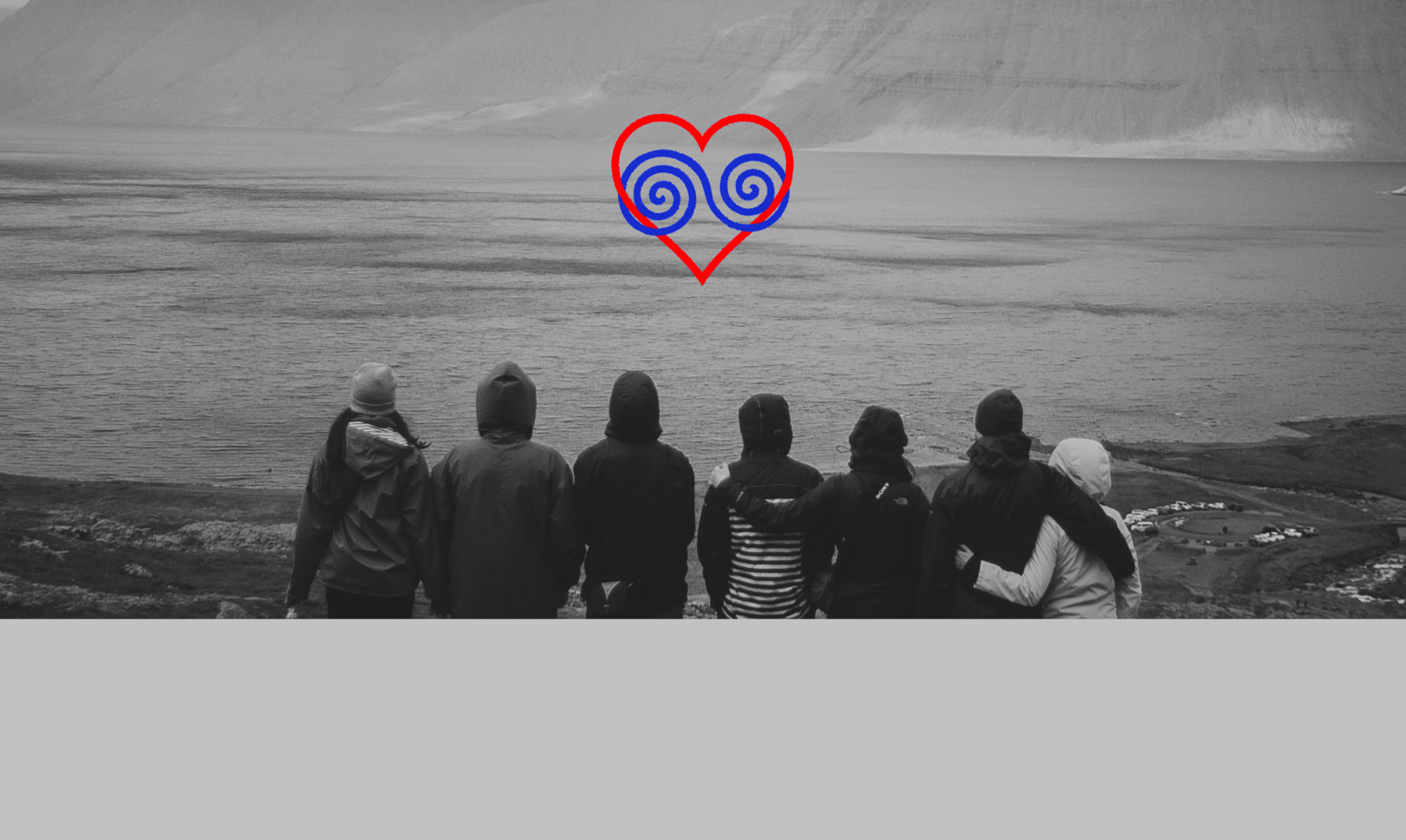Fresh out of the pan…*
Our journey through 2021 is coming to an end, so I would like to dedicate my last entry this year to two oligoamorous impulses that I have gained through both my mono-amorous and poly-amorous relationship experiences.
Already in Entry 29 I say what I would almost like to write on every page of my bLog instead of my long Entries, if this could be enough as an essence: “Maintain good relationships!”.
And I am convinced that, strictly speaking, this simple imperative is decisive for every form of trusting, heartfelt personal interaction – no matter how many people are sitting together in the respective relationship-boat in the end.

Most of my readers, like me, probably hail from the “old world of Mono-amory” – and that’s probably where they, too, picked up their first relationship skills.
Thus, at this point, I therefore would like to take up the cudgels for this customary convention.
Because as far as the level of intensity is concerned, there is probably no more pervasive arrangement than that of two people in a 1:1 situation.
Yes, all right – I have heard your thoughts: “…but for better or worse…” – and I also agree with that. But today, perhaps, let us also look upon “better”.
After all, the “romantic dyadic relationship” (= between only two people) is still such a marketable glamour-model because it does not advertise an agreement (which it is in essence!), but an ideal (which it is as well !).
But when it comes to ideals – which I also appreciate very much in my Oligoamory – that’s one of those things… We love the heroic and radiant moments that such a narrative promises – but we are good at ignoring (or at least downplaying…) the necessities that come with it and even more the inevitability of routine that sets in medium term.
However, when agreement and ideal meet, then a relationship between two people can, in a sense, represent the epitome of the “emotional contract“ I so often cite on my bLog: A shared savouring of the totality of the voluntary yielded obligations, self-commitments and care which have been reciprocally contributed.
This – let it melt on your tongue! – is already a lot, tremendously much, and a promise of mutual happiness, well-being and security (including predictability) for those involved.
Potentiated with the romantic motive of the “voluntarily performed self-sacrifice for the sake of the community (here: the relationship – for more details see Entry 34)”, the enormous radiance of such a promise is, so to speak, unsurpassable.
Romantic cover-up, wishful dream glued together with pink cotton candy, reality-defying soap(opera)-bubble?
I want to tell you that I have experienced (and experience every day!) all that I have written in the above paragraph exactly like this in my dyadic relationships.
The investment and commitment of my partners in and towards me was and is gigantic at all times. And completely non-self-evident.
The degree of cooperation, consideration, dedication, devotion, affection, attentiveness, inclusion, yes, involvement (Entry 53), which I have received especially in my long-term relationships, definitely exceeds any scope of common everyday business – and certainly any acclaimed performance level of every otherwise earthly transaction experience.
“Huh, Oligotropos is now comparing his loved ones to mere service providers…?”
Yes, correct, I am doing that to some degree in this way – precisely to show that there must be some sublime metaphysical component involved here that is not present in any other form of interpersonal agreement – which is love.
“Love” which tangibly proves to me in every little everyday gesture of accommodation by my favourite person: I am seen, I am obviously significant concerning the self-image of my counterpart, I thereby experience appreciation for my own self due to my inalienable intrinsic value [which is recognized and appreciated by the other person, oh bliss!], therefore I can dedicate myself here with trust and may further build upon it.
What I have just formulated is indeed SO much need¹ coverage to a human mind that some dangers can arise from this abundance itself.
One is the now well-documented phenomenon known as the “law of diminishing marginal returns,” which the behavioural economist Daniel Kahneman analysed extensively back in 2000² . We all know the phenomenon better as a variation of the “force of habit”, when we no longer consider something positive as special because we experience it on a regular basis. Surveys proved, that even an increase of positivity quickly soon led to a diminishing effect of recurring habituation – and, as we all know, this is not only an economic dilemma, but a real emotional challenge for any close relationship.
Indeed, on the proverbial ” ill days” of our relationships, this makes it too easy to accept the “totality of voluntary yielded obligations, self-commitments and care which have been reciprocally contributed” in our relationship either as an implicitness, an end in itself, or just as profane barter (quid pro quo). And even an (one-sided) effort at positive improvement will all too quickly lead to renewed habituation to whatever is offered.
It is exactly this dilemma that makes many couple therapists rich, since particularly in this critical situation, a mere two-person relationship is often too constricted for its participants to step back far enough on their own to be able to independently recover the inner richness of their companionship. Here, in fact, polyamorous multiple partnerships often have an advantage, because precisely the dynamics of a multi-person constellation with its – simply due to the diversity of those involved – differently pronounced view of the “common core” will not so easily take the “overall well-being” for granted, as can happen with just two people who, already wedged nose-to-nose, abruptly suspect their invested self-interest is on sale.
And this very same “dark side” regarding the “property preservation of the comfort zone” also leads to all the extreme upsurges of e.g. jealousy or envy, if the attempt of opening up a two-person relationship is dared.
All advice literature is full of admonitions about opening up monogamous relationships only when internal conditions are completely stabilized and there is a high degree of mutual agreement – but never to let in the famous “breath of fresh air” when some discontent is already lurking at the edges of the board.
Because: The internal “emotional contract” of a relationship between just two people is almost always a somewhat delicate matter, in that this is usually a subtly balanced and entwined interrelatedness of not always consciously contributed and “enjoyed” elements.
Being a former monoamorist myself, I don’t find that all too objectionable, by the way. Yes, true, unconsciousness is certainly never a helpful quality – and Mono-amory would also benefit from more consciously and fully transparently established relationships. However, since Mono-amory is anyway tailored to only two possible participants, the “all-or-nothing” nature of its conception at this point allows for a possible degree of, um…, lightheartedness, entrusting any unconsciously submitted risk potentials to the resilience of the emerging relationship (which was admittedly awkward – but at the same time also tremendously attractive to the mono-model for centuries…). The result is in any case that well-known dyadic tandem, where two worlds are merged in such a way with each other, that course, speed and stability will inevitably go to the weal as well as to the woe of both riders, whereby on the one hand the intensity of the spent internal synchronization – but on the other hand also the mutual dependency – can become very high.
If now such an arrangement is opened up to new participants, it will inevitably lead to an experience of displacement and asymmetry.
The higher the unconscious parts of compensatory nature (e.g. because of suffered deficiencies during childhood or socialization) are, the higher these displacements are experienced as painful shearing forces regarding one’s own need coverage. In fact, from my point of view, envy (Entry 59) and jealousy (Entry 36) always bring up the perturbing question concerning one’s own “inalienable intrinsic value” (see above).
So if an upcoming (multiple) relationship constellation is experienced primarily as a drain on resources and not as a “community of gain” with a re-established emotional centre of “a totality of voluntary yielded obligations, self-commitments and care which are reciprocally contributed” – then the initially perhaps only “felt” shear forces will soon gain the upper hand in a very real way and cause suffering to all involved up to the point relationship-breakup.
So, as I wrote in the last entry, Poly-amory (and of course Oligoamory) need all of the above at any rate : an agreement by (self)commitment, common ideals AND love – and the latter by all and for all involved, if the whole thing is to sustain a future perspective.
Which, in fact, already brings me to my experiences via Polyamory.
When I think about these in more detail, I believe I am struck most impressively by how much I have learned that one should never try to model relationships after one another according to a certain personal “feel-good” pattern.
For some this may sound like a truism – or others might think that this lesson can be experienced very well in serial monogamy either.
In a sense, I agree with that – at the same time, it’s exactly the actual multi-person constellation again that is the best insurance against routinised self-sabotage.
“Every relationship is unique”, sure, another truism, ha, – how should it be possible to make them alike…?
And yet this danger exists when “we” are exactly one of the reference points of our close relationships on each occasion – and strive every time to incorporate our own “need recognition” into them as well. This is because our “need recognition” drags along on a kind of virtual tow-line our above-mentioned “comfort zone”, where convenience and pleasant habit can instigate us to try whether we couldn’t set up another similarly constituted familiarity-refuge for ourselves… Even our brains, about which we know since Entry 25 that they would like to experience nothing better than as much as possible comparable coherence (consistency / sense of connection), can become almost overzealous accomplices to our weaker self here.
Well, but there would still be the respective loved ones in their diversity, which, as far as “cooperation, consideration, dedication, devotion, affection, attentiveness, inclusion, and involvement” are concerned, would be – individual by individual – entirely differently positioned.
By which, however, we would make things a little bit too easy for ourselves, especially if we were to shift the responsibility entirely to the hemisphere of our loved ones, to lure us out of our harmony-seeking comfort-zone uniformity. Because at the same time they would regularly experience the (right!) impression to work against some invisible pushback on our side – while we are actually striving in the enterprise to add them for their part as a pretty keystone into our very own comfort closet.
No, multiple relationships never allow such neat manipulations for very long, until they are soon brought up to the table.
Which to me is one of the most wonderful features of ethical non-monogamy.
Because no matter how I want to twist and turn it, the insularity and being-encapsulated-in-each-other of a two-person configuration is no longer possible here. So in a way, I’m definitely more exposed – does that inevitably mean I have to live with some loss of safety and familiarity in Poly-/Oligoamory?
I don’t think so. Because if love is involved, it means that I am seen, I am obviously of importance for the self-image of my counterpart, I thereby experience appreciation for my own self due to my inalienable intrinsic value [which is recognized and appreciated by several other people, oh bliss!], therefore I can dedicate myself here with trust and may further build upon it.
Ethical and sustainable, as well as love-based multiple relationships unfold their grandest potential at this point:
I am important to several people and therefore I am seen by them – but it is highly unlikely that they all refer to the same aspect of mine.
Several people express that I have meaning for their self-image and that I am a part of their lives – but very different lives and biographies, of which I may now be a valuable, contributing element.
My “inalienable intrinsic value” is valued at the highest by several people – and that means the greatest of all in the matter: That my intrinsic value must be extremely versatile and multifaceted, perhaps even greater than I am capable of perceiving myself at the moment.
In this way, the gift of ethical multiple partnerships comes to me once again in a very festive way: to be more than the sum of the parts.
The danger of succumbing to a lullaby comfort zone, which I therefore might at some point consider as the appropriate standard that I am entitled to every day, is thus also significantly reduced. In the book of my life, every day new pages can be surprisingly revealed by my loved ones, pages that I would perhaps rather not have touched myself. Thus, sometimes it will cost me courage to see myself as the main character on these pages…
But as the legendary Chinese philosopher Laozi knew already in the sixth century B.C.: “Great love makes a person brave.”
And so I myself very likely will also feel the desire to explore this versatile and multifaceted person, which I obviously am in the eyes of my loved ones, and to appreciate and unfold it more and more thoroughly on my part.
Which is probably what the French writer Marcel Proust already felt in equal measure when he noted in his epic novel “In Search of Lost Time“ :
“Let us be grateful to the people who make us happy. They are kind gardeners who make our souls bloom.”
*Refers to a line in the 1970 song “Sweet Gingerbread Man“ with music by Michel Legrand and lyrics by Alan Bergman and Marilyn Bergman. Prominent performers were Sammy Davis Jr., Sarah Vaughan and the Muppets 😉
¹ When I speak of need on this bLog (my regular readers know), I always refer to its use as a personality trait according to humanistic psychology, e.g. as defined by A. Maslow, C. Alderfer and M. Rosenberg.
² Kahnemann, D., Experienced utility and objective happiness: A moment-based approach. In: Kahnemann, D. and Tversky, A. – „Choices, Values and Frames“, New York 2000
Thanks to Oriol Portell on Unsplash for the ginger crowd!

